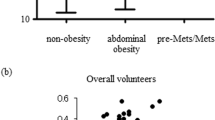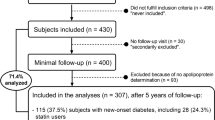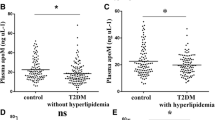Abstract
The relevance of serum apolipoprotein E (apoE) levels to two hypertriglyceridemic dyslipidemias has not been clarified. We explored, in a cross-sectional (and short-term prospective) evaluation, the independent relationship of serum apoE to the atherogenic dyslipidemia, hypertriglyceridemia with elevated apoB (HtgB) and to apoA-I dysfunctionality, previously shown in Turkish adults to be independent of apoE genotype. Serum apoE concentrations were measured by immunonephelometry in 1,127 middle-aged adults. In multivariable regression analysis, apoE concentrations showed log-linear associations with apoB and apoA-I levels, waist circumference, independent of C-reactive protein (CRP), homeostatic model assessment (HOMA) index and other confounders. The likelihood of atherogenic dyslipidemia and of HtgB roughly tripled per 1-SD increment in apoE concentrations, additively to apoE genotype, HOMA, apoA-I, CRP concentrations and waist circumference; yet apoA-I, protective against atherogenic dyslipidemia, appeared to promote HtgB, a finding consistent with apoA-I dysfunctionality in this setting. Each 1-SD increment in the apoE level was moreover, associated in both genders with MetS (at OR 1.5), after adjustment for sex, age, apoB, apoA-I and CRP, or for apoE genotypes. Circulating apoE predicted in both genders age-adjusted prevalent and incident coronary heart disease (CHD), independent of apoE genotype and CRP (OR 1.32 [95 % CI 1.11; 1.58]). To conclude, in a general population prone to MetS, elevated apoE concentrations are strongly linked to HtgB and atherogenic dyslipidemia, irrespective of apoE genotype, are associated with MetS and CHD. Excess apoE reflects pro-inflammatory state and likely autoimmune activation.

Similar content being viewed by others
Abbreviations
- apo:
-
Apolipoprotein
- LDL:
-
Low-density lipoprotein
- CHD:
-
Coronary heart disease
- Lp(a):
-
Lipoprotein(a)
- CRP:
-
C-reactive protein
- MetS:
-
Metabolic syndrome
- HDL:
-
High-density lipoprotein
- SHBG:
-
Sex hormone-binding globulin
- HOMA:
-
Homeostatic model assessment
- TARF:
-
Turkish adult risk factor study
- HtgB:
-
Hypertriglyceridemia with elevated apoB
- VLDL:
-
Very low-density lipoprotein
References
Mahley RW, Ji ZS (1999) Remnant lipoprotein metabolism: key pathways involving cell-surface heparan sulfate proteoglycans and apolipoprotein E. J Lipid Res 10:1–16
Dallongeville J, Lussier-Cacan S, Davignon S (1992) Modulation of plasma triglyceride levels by apoE phenotype: a meta-analysis. J Lipid Res 33:447–454
Bennet AM, Di Angelantonio E, Ye Z et al (2007) Association of apolipoprotein E genotypes with lipid levels and coronary risk. JAMA 298:1300–1311
Dominczak MH, Caslake MJ (2011) Apolipoproteins: metabolic role and clinical biochemistry applications. Ann Clin Biochem 48:498–515
Huang Y (2010) Mechanisms linking apolipoprotein E isoforms with cardiovascular and neurological disease. Curr Opin Lipidol 21:337–345
Onat A, Hergenç G, Ayhan E et al (2007) Serum apolipoprotein E concentrations among Turks: additive information to genotype relative to dyslipidemia and metabolic syndrome. Arch Turk Soc Cardiol 35:449–457
Söderlund S, Watanabe H, Ehnholm C et al (2010) Increased apolipoprotein E level and reduced high-density lipoprotein mean particle size associate with low high-density lipoprotein cholesterol and features of metabolic syndrome. Metabolism 59:1502–1509
Mooijaart SP, Berbée JFP, van Heemst D et al (2006) ApoE plasma levels and risk of cardiovascular mortality in old age. PLoS Med 3:e176
Corsetti JP, Bakker SJ, Sparks CE, Dullaart RP (2012) Apolipoprotein A-II influences apolipoprotein E-linked cardiovascular disease in women with high levels of HDL cholesterol and C-reactive protein. PLoS One 7:e39110
Onat A, Can G, Ayhan E et al (2009) Impaired protection against diabetes and coronary disease by high-density lipoproteins in Turks. Metabolism 58:1393–1399
Onat A, Hergenç G (2011) Low-grade inflammation and dysfunction of high-density lipoprotein and its apolipoproteins as a major driver of cardiometabolic risk. Metabolism 60:499–512
Onat A, Hergenç G, Bulur S et al (2010) The paradox of high apolipoprotein A-I levels independently predicting incident type-2 diabetes among Turks. Int J Cardiol 142:72–79
Onat A, Kömürcü-Bayrak E, Can G et al (2010) Apolipoprotein A-I positively associated with diabetes in women independently of apoE genotype and apolipoprotein B levels. Nutrition 26:975–980
Packard CJ, Ford I, Robertson M et al (2005) Plasma lipoproteins and apolipoproteins as predictors of cardiovascular risk and treatment benefit in the prospective study of pravastatin in the elderly at risk. (PROSPER). Circulation 112:3058–3065
Ray KK, Cannon CP, Cairns CP et al (2009) Prognostic utility of apoB/AI, total cholesterol/HDL, non-HDL cholesterol, or hs-CRP as predictors of clinical risk in patients receiving statin therapy after acute coronary syndromes: results from PROVE IT-TIMI 22. Arterioscler Thromb Vasc Biol 29:424–430
Onat A (2001) Risk factors and cardiovascular disease in Turkey. Atherosclerosis 156:1–10
Grundy SM, Brewer HB, Cleeman JI et al (2004) Definition of metabolic syndrome: report of the National Heart, Lung, and Blood Institute/American Heart Association conference on scientific issues related to definition. Circulation 109:433–438
Onat A, Uyarel H, Hergenç G et al (2007) Determinants and definition of abdominal obesity as related to risk of diabetes, metabolic syndrome and coronary disease in Turkish men: a prospective cohort study. Atherosclerosis 191:182–190
Genuth S, Alberti KG, Bennett P et al (2003) Expert committee on the diagnosis and classification of diabetes mellitus. Follow-up report on the diagnosis of diabetes mellitus. The expert committee on the diagnosis and classification of diabetes mellitus. Diabetes Care 26:3160–3167
Mather KJ, Hunt AE, Steinberg HO et al (2001) Repeatability characteristics of simple indices of insulin resistance: implications for research applications. J Clin Endocrinol Metab 86:5457–5464
Rose GA, Blackburn H, Gillum RF et al (1982) Cardiovascular survey methods, 2nd edn. WHO, Geneva, pp 124–127
Greenow K, Pearce NJ, Ramji DP (2005) The key role of apolipoprotein E in atherosclerosis. J Mol Med 83:329–342
Onat A, Can G, Hergenç G et al (2007) Serum apolipoprotein B predicts dyslipidemia, metabolic syndrome and, in women, hypertension and diabetes, independent of markers of central obesity and inflammation. Int J Obes 31:1119–1125
Sniderman A, Scantlebury T, Cianflone K (2001) Hypertriglyceridemic hyperapoB: the unappreciated atherogenic dyslipoproteinemia in type 2 diabetes mellitus. Ann Intern Med 135:447–459
Janis MT, Metso J, Lankinen H et al (2005) Apolipoprotein activates the low-activity form of human phospholipid transfer protein. Biochem Biophys Res Commun 331:333–340
Francis GA (2010) The complexity of HDL. Biochim Biophys Acta 1801:1286–9324b
Vaisar T, Pennathur S, Green PS et al (2007) Shotgun proteomics implicates protease inhibition and complement activation in the antiinflammatory properties of HDL. J Clin Invest 117:746–756
Park KH, Shin DG, Kim JR et al (2010) The functional and compositional properties of lipoproteins are altered in patients with metabolic syndrome with increased cholesteryl ester transfer protein activity. Int J Mol Med 25:129–136
Haase CL, Tybjaerg-Hansen A, Grande P et al (2010) Genetically elevated apolipoprotein A-I, high-density lipoprotein levels, and risk of ischemic heart disease. J Clin Endocrinol Metab 95:E500–E510
Barbagallo CM, Rizzo M, Noto D et al (2006) Accumulation of apoE-enriched triglyceride-rich lipoproteins in patients with coronary artery disease. Metabolism 55:662–668
Van den Elzen P, Garg S, Léon L et al (2005) Apolipoprotein-mediated pathways of lipid antigen presentation. Nature 437:906–910
Ogasawara K, Mashiba S, Hashimoto H et al (2008) Low-density lipoprotein (LDL), which includes apolipoprotein A-I (apoAI-LDL) as a novel marker of coronary artery disease. Clin Chim Acta 397:42–47
Cigliano L, Pugliese CR, Spagnuolo MS et al (2009) Haptoglobin binds the antiatherogenic protein apolipoprotein E—impairment of apolipoprotein E stimulation of both lecithin: cholesterol acyltransferase activity and cholesterol uptake by hepatocytes. FEBS J 276:6158–6171
Acknowledgments
We thank the Turkish Society of Cardiology and the pharmaceutical companies AstraZeneca and Servier, İstanbul, which have financially supported the Turkish Adult Risk Factor surveys and thank the Turkish Ministry of Health for logistic support. We appreciate the input of G. Hergenç, Ph.D., in biochemical analyses and the dedicated works of G. Çiçek, MD, and Mr. M. Özmay in the survey teams.
Conflict of interest
No conflict of interest is declared by any author.
Author information
Authors and Affiliations
Corresponding author
About this article
Cite this article
Onat, A., Can, G., Örnek, E. et al. High Serum Apolipoprotein E Determines Hypertriglyceridemic Dyslipidemias, Coronary Disease and ApoA-I Dysfunctionality. Lipids 48, 51–61 (2013). https://doi.org/10.1007/s11745-012-3724-8
Received:
Accepted:
Published:
Issue Date:
DOI: https://doi.org/10.1007/s11745-012-3724-8




